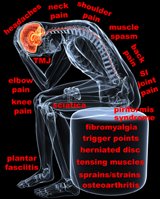What are Pain Liberation Movements?
Pain Liberation Movements(TM) (PLM) is a method formulated by Dr. Howard A. Knudsen, a Provo physical therapist. The technique is based on on the best aspects of various manual therapy techniques with an additional touch of inspiration.
Although it works better when performed by a manual therapist with advanced anatomical knowledge and palpation skills, it is effective enough for a beginner to get positive results.
The theory is based on Dr. Knudsen observation of back pain patient's abdominal muscles during over a thousand ultrasound imaging examinations. Even though his patients were examined while lying down in a resting position, they showed signs of extreme contraction of one or more abdominal muscles.
He noted that even though he could almost always get a patient's muscles to relax with a special technique, he or she would return to the same muscle hyper-contraction after getting up off the table. He searched for an answer to this problem that seems to maintain chronic pain, never allowing it to go through a process of natural self-healing.
He studied the latest brain research to find part of the answer. Multiple scientific studies show a distortion in the communication between the brain and body.
After further study, Dr. Knudsen realized that this communication distortion is cause by many factors involving the body and the brain. The chief culprit in the brain is the amygdala, which has been termed the "fear center." The amygdala is always looking for threats and when it identifies one it instigates a hyper-arousal state in the body.
The structures in the body that have the most potential to create distortion between our brain and body talk include spinal misalignments and protective muscle reflexes. Pain Liberation Movements focus on turning off long-standing protective muscle reflexes.
What is a protective muscle reflex?
Suppose you step on a tack in your bare feet. Before you know it your leg has reflexively lifted off the floor. This is called a "withdrawal reflex." The reflex causes the leg muscles to automatically shorten or contract to pull the foot off the ground. Think of the amaygdala as a puppeteer, pulling the string to make us move.
What if you never removed the tack? The amygdala would learn to turn those particular protective muscle reflexes on indefinitely. It would become an automatic pattern that is memorized.
This may happen with any body part.
For instance, a toothache can cause the TMJ (jaw) muscles to amplify and maintain the pain. When you bite down and feel pain multiple times the amygdala learns the new muscle hyper-contraction pattern. The same thing is possible with neck pain, headaches, back pain, joint pain, plantar fasciitis, abdominal cramps, carpal tunnel, and possible any type of pain.
The treatment involves finding tender spots and then identifying the myofascial meridians that cross through the region.
Once we turn off the protective muscle reflex, health messages begin to be sent and a natural self-healing response is initiated.
The technique is also based on a newly identified system of anatomy, called myofascial meridians or fascia lines by Tom Meyers, author of Anatomy Trains, 2nd Edition. The following video is an introduction to Anatomy Trains. I use his ideas to enhance my treatment strategies, especially with chronic problems.
This video helps to descibe some of his profound ideas on how the body functions like a sail boat not a crane.
 We treat the whole body!
We treat the whole body!